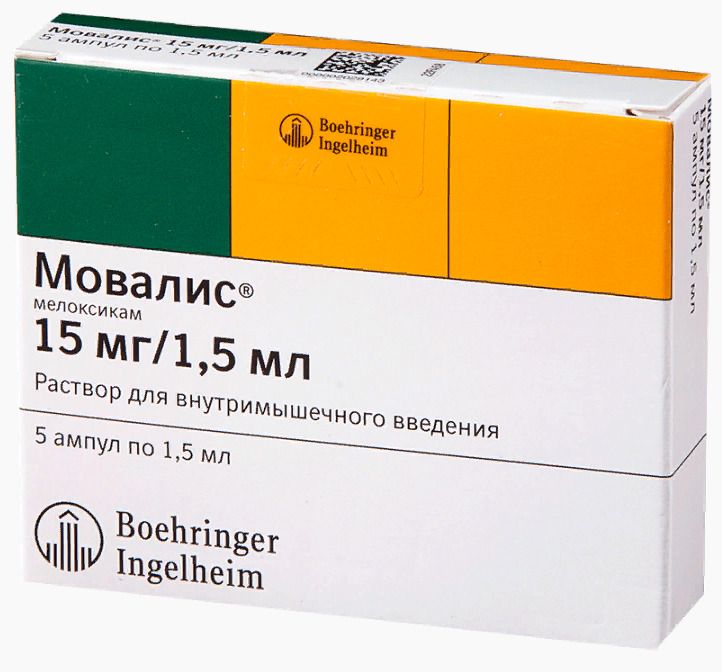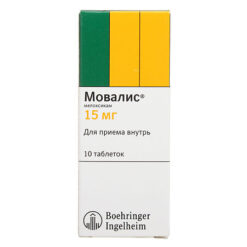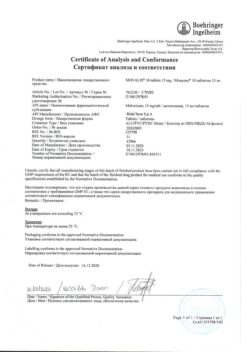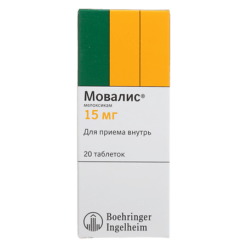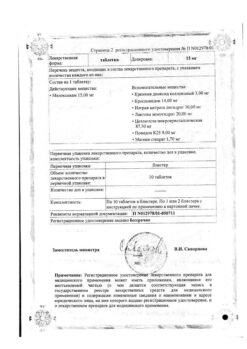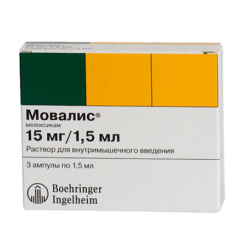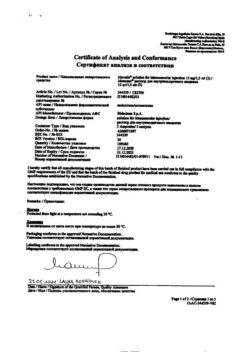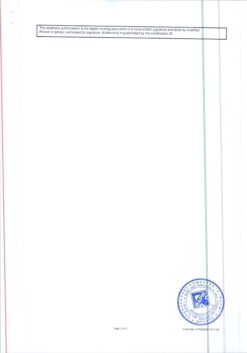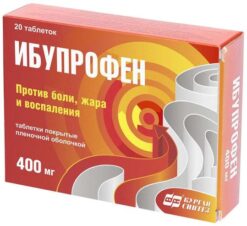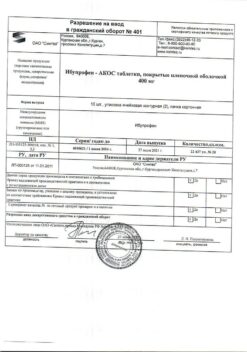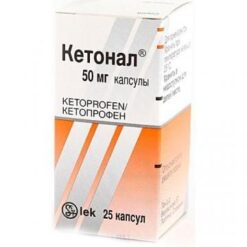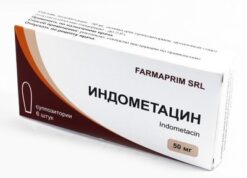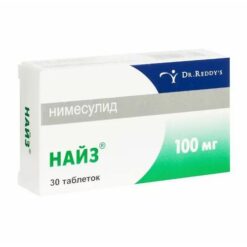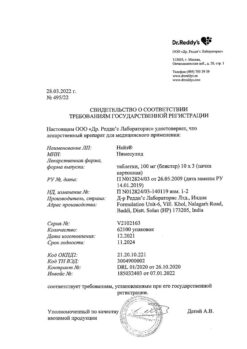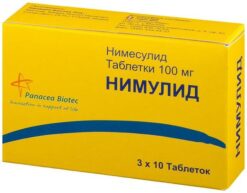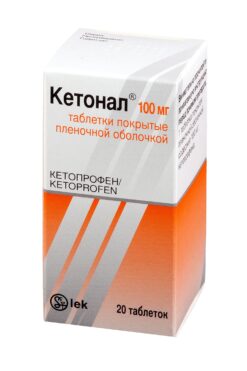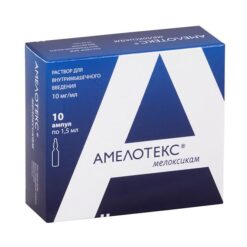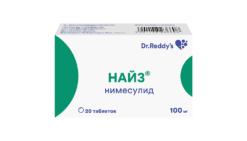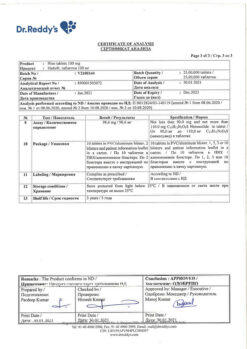No products in the cart.
Movalis, 15 mg/1.5 ml 1.5 ml 5 pcs.
€70.45 €63.98
Description
Movalis is a non-steroidal anti-inflammatory drug, refers to enolic acid derivatives and has anti-inflammatory, analgesic and antipyretic effects. The pronounced anti-inflammatory effect of meloxicam was established in all standard models of inflammation. The mechanism of action of meloxicam is its ability to inhibit the synthesis of prostaglandins – known mediators of inflammation.
In vivo meloxicam inhibits prostaglandin synthesis at the site of inflammation to a greater extent than in the gastric mucosa or kidney.
These differences are due to more selective inhibition of cyclooxygenase-2 (COX-2) compared to cyclooxygenase-1 (COX-1). Inhibition of COX-2 is thought to provide the therapeutic effect of NSAIDs, whereas inhibition of the ever-present COX-1 isoenzyme may cause gastric and renal side effects.
The selectivity of meloxicam against COX-2 has been confirmed in various test systems, both in vitro and ex vivo. The selective ability of meloxicam to inhibit COX-2 was shown when using human whole blood as a test system in vitro. Ex vivo, meloxicam (at doses of 7.5 and 15 mg) was found to be more active in inhibiting COX-2, having a greater inhibitory effect on lipopolysaccharide-stimulated prostaglandin E2 production (COX-2-controlled response) than on thromboxane production involved in blood clotting (COX-1-controlled response). These effects were dose-dependent. Ex vivo, meloxicam at the recommended doses was shown to have no effect on platelet aggregation and bleeding time, in contrast to indomethacin, diclofenac, ibuprofen and naproxen, which significantly inhibited platelet aggregation and increased bleeding time.
In clinical trials, gastrointestinal (GI) side effects were generally less frequent with meloxicam 7.5 and 15 mg than with the other NSAIDs compared. This difference in the frequency of gastrointestinal side effects is mainly due to the fact that such phenomena as dyspepsia, vomiting, nausea, and abdominal pain were observed less frequently while taking meloxicam. The frequency of upper gastrointestinal perforations, ulcers and bleeding associated with the use of meloxicam was low and depended on the size of the dose of the drug.
Pharmacokinetics:
Meloxicam is completely absorbed after intramuscular administration. The relative bioavailability compared to the bioavailability with oral administration is almost 100%. Therefore, no dose adjustment is required when switching from injectable to oral forms. After administration of 15 mg of the drug intramuscularly, the peak plasma concentration of about 1.62 mcg/ml is reached within about 60 minutes.
Distribution
Meloxicam binds very well to plasma proteins, especially to albumin (99%). It penetrates the synovial fluid, the concentration in synovial fluid is approximately 50% of the plasma concentration. The volume of distribution is low, averaging 11 L. Interindividual variation is 30-40%.
Metabolism
Meloxicam is almost completely metabolized in the liver to form 4 pharmacologically inactive derivatives. The main metabolite, 5′-carboxymeloxicam (60% of the dose value), is formed by oxidation of the intermediate metabolite, 5′-hydroxymethylmeloxicam, which is also excreted, but to a lesser extent (9% of the dose value). In vitro studies have shown that CYP 2C9 plays an important role in this metabolic transformation, CYP 3A4 isoenzyme has additional importance. Peroxidase, the activity of which probably varies individually, is involved in the formation of the other two metabolites (which are, respectively, 16% and 4% of the drug dose).
Elimation
It is excreted equally in the feces and urine, mainly as metabolites. Less than 5% of daily dose is excreted unchanged in feces, the drug is excreted unchanged in urine only in trace amounts. The average half-life of meloxicam is 20 hours. Plasma clearance averages 8 ml/min. Meloxicam exhibits linear pharmacokinetics at doses of 7.5 to 15 mg when administered orally or intramuscularly.
Hepatic and/or renal function deficiencies
Liver function deficiencies and mild to moderate renal insufficiency have no significant effect on the pharmacokinetics of meloxicam.
In terminal renal failure, increased volume of distribution may lead to higher concentrations of free meloxicam, so in these patients the daily dose should not exceed 7.5 mg.
Elderly patients
Elderly patients have slightly lower mean plasma clearance during steady state pharmacokinetics than younger patients.
Indications
Indications
The drug Movalis in the dosage form of a solution for intramuscular administration is indicated for the initial period of treatment and short-term symptomatic treatment of pain syndrome in rheumatoid arthritis, osteoarthritis, and ankylosing spondylitis.
Pharmacological effect
Pharmacological effect
Movalis is a non-steroidal anti-inflammatory drug, belongs to enolic acid derivatives and has anti-inflammatory, analgesic and antipyretic effects. The pronounced anti-inflammatory effect of meloxicam has been established in all standard models of inflammation. The mechanism of action of meloxicam is its ability to inhibit the synthesis of prostaglandins, known mediators of inflammation.
In vivo, meloxicam inhibits prostaglandin synthesis at the site of inflammation to a greater extent than in the gastric mucosa or kidneys.
These differences are due to more selective inhibition of cyclooxygenase-2 (COX-2) compared with cyclooxygenase-1 (COX-1). Inhibition of COX-2 is thought to provide the therapeutic effect of NSAIDs, whereas inhibition of the constitutively present COX-1 isoenzyme may be responsible for gastric and renal side effects.
The selectivity of meloxicam for COX-2 has been confirmed in various test systems, both in vitro and ex vivo. The selective ability of meloxicam to inhibit COX-2 was demonstrated when using human whole blood as a test system in vitro. Ex vivo, it was found that meloxicam (in doses of 7.5 and 15 mg) more actively inhibited COX-2, having a greater inhibitory effect on the production of prostaglandin E2 stimulated by lipopolysaccharide (reaction controlled by COX-2) than on the production of thromboxane involved in the blood coagulation process (reaction controlled by COX-1). These effects were dose dependent. Ex vivo it was shown that meloxicam at recommended doses did not affect platelet aggregation and bleeding time, in contrast to indomethacin, diclofenac, ibuprofen and naproxen, which significantly suppressed platelet aggregation and increased bleeding time.
In clinical studies, gastrointestinal (GI) side effects were generally less common with meloxicam 7.5 and 15 mg than with other NSAIDs compared. This difference in the frequency of side effects from the gastrointestinal tract is mainly due to the fact that when taking meloxicam, such phenomena as dyspepsia, vomiting, nausea, and abdominal pain were observed less frequently. The incidence of upper gastrointestinal perforations, ulcers and bleeding associated with meloxicam use was low and dose dependent.
Pharmacokinetics:
Meloxicam is completely absorbed after intramuscular administration. Relative bioavailability compared to oral bioavailability is almost 100%. Therefore, when switching from injection to oral forms, dose selection is not required. After administration of 15 mg of the drug intramuscularly, a peak plasma concentration of about 1.62 μg/ml is achieved within approximately 60 minutes.
Distribution
Meloxicam binds very well to plasma proteins, especially albumin (99%). Penetrates into synovial fluid, the concentration in synovial fluid is approximately 50% of the concentration in plasma. The volume of distribution is low, averaging 11 L. Interindividual differences are 30 -40%.
Metabolism
Meloxicam is almost completely metabolized in the liver to form 4 pharmacologically inactive derivatives. The main metabolite, 5′-carboxymeloxicam (60% of the dose), is formed by oxidation of an intermediate metabolite, 5′-hydroxymethylmeloxicam, which is also excreted, but to a lesser extent (9% of the dose). In vitro studies have shown that CYP 2C9 plays an important role in this metabolic transformation, and the CYP 3A4 isoenzyme is of additional importance. Peroxidase is involved in the formation of the other two metabolites (constituting, respectively, 16% and 4% of the drug dose), the activity of which probably varies individually.
Removal
It is excreted equally in feces and urine, mainly in the form of metabolites. In unchanged form, less than 5% of the daily dose is excreted in feces; in urine, unchanged, the drug is found only in trace amounts. The average half-life of meloxicam is 20 hours. Plasma clearance averages 8 ml/min. Meloxicam exhibits linear pharmacokinetics in doses of 7.5–15 mg when administered orally or intramuscularly.
Insufficiency of liver and/or kidney function
Failure of liver function, as well as mild or moderate renal failure, do not have a significant effect on the pharmacokinetics of meloxicam.
In end-stage renal failure, an increase in volume of distribution may result in higher concentrations of free meloxicam, so in these patients the daily dose should not exceed 7.5 mg.
Elderly patients
In elderly patients, the mean plasma clearance during steady state pharmacokinetics is slightly lower than in younger patients.
Special instructions
Special instructions
Caution should be exercised (as with other NSAIDs) when treating patients with a history of gastrointestinal diseases. Patients experiencing gastrointestinal symptoms should be monitored regularly. If ulcerative lesions of the gastrointestinal tract or gastrointestinal bleeding occur, Movalis® should be discontinued.
As with the use of other NSAIDs, potentially life-threatening gastrointestinal bleeding, ulcers and perforations may occur during treatment at any time, whether or not there are warning signs or a history of serious gastrointestinal complications.
The consequences of these complications are generally more serious in older people. Particular attention should be paid to patients reporting the development of adverse events from the skin and mucous membranes. In such cases, discontinuation of Movalis should be considered.
NSAIDs inhibit the synthesis of prostaglandins in the kidneys, which are involved in maintaining renal perfusion. The use of NSAIDs in patients with reduced renal blood flow or reduced circulating blood volume may lead to decompensation of latent renal failure. After discontinuation of NSAIDs, renal function usually returns to baseline levels.
Elderly patients are most at risk of developing this reaction; patients who have dehydration, congestive heart failure, liver cirrhosis, nephrotic syndrome or overt kidney disease;
patients receiving diuretics, ACE inhibitors, angiotensin II receptor antagonists, as well as patients who have undergone major surgical procedures leading to hypovolemia. In such patients, diuresis and renal function should be carefully monitored when initiating therapy.
In rare cases, NSAIDs may cause interstitial nephritis, glomerulonephritis, medullary renal necrosis, or nephrotic syndrome.
In patients with end-stage renal failure on hemodialysis, the dose of Movalis should not exceed 7.5 mg. In patients with mild or moderate renal impairment (that is, if creatinine clearance is more than 25 ml/min), no dose reduction is required.
When using the drug Movalis® (as well as most other NSAIDs), episodic increases in the level of transaminases or other indicators of liver function in the blood serum have been reported. In most cases, this increase was small and transitory. If the detected changes are significant or do not decrease over time, Movalis® should be discontinued and the detected laboratory changes should be monitored.
In patients with clinically stable liver cirrhosis, a dose reduction is not required.
Weakened or malnourished patients may be less able to tolerate adverse events and such patients should be monitored closely. Caution (as with other NSAIDs) should be used when treating elderly patients who are more likely to have impaired renal, hepatic and cardiac function.
The use of NSAIDs in combination with diuretics can lead to sodium, potassium and water retention, and affect the natriuretic effect of diuretics. As a result, predisposed patients may experience increased signs of heart failure or hypertension.
Meloxicam, like other NSAIDs, can mask the symptoms of an infectious disease.
The use of meloxicam, like other drugs that block cyclooxygenase/prostaglandin synthesis, may affect fertility and is therefore not recommended for women wishing to become pregnant. If the ability to conceive in women is impaired or when undergoing examination for infertility, it is necessary to consider discontinuing meloxicam.
No special studies have been conducted regarding the effect of the drug on the ability to drive vehicles and operate machinery. Patients with visual impairments, patients experiencing drowsiness or other disorders of the central nervous system should refrain from this activity.
Active ingredient
Active ingredient
Meloxicam
Composition
Composition
Active ingredient:
meloxicam 15 mg;
Excipients:
meglumine;
glycofurol;
poloxamer 188 (Pluronic F68);
sodium chloride;
glycine;
sodium hydroxide;
water for injections
Contraindications
Contraindications
Hypersensitivity;
a history of symptoms of bronchial asthma, nasal polyps, angioedema or urticaria after taking acetylsalicylic acid or other NSAIDs;
peptic ulcer/perforation of the stomach and duodenum in the acute stage or recently suffered;
Crohn’s disease or ulcerative colitis in the acute stage;
severe liver failure;
severe renal failure (if hemodialysis is not performed, creatinine Cl less than 30 ml/min, as well as with confirmed hyperkalemia), progressive kidney disease;
acute gastrointestinal bleeding, recent cerebrovascular bleeding or an established diagnosis of diseases of the blood coagulation system;
severe uncontrolled heart failure;
therapy of perioperative pain during coronary artery bypass surgery.
Side Effects
Side Effects
From the hematopoietic organs: changes in the number of blood cells, including changes in the leukocyte formula, leukopenia, thrombocytopenia, anemia. A predisposing factor for the occurrence of cytopenias appears to be the simultaneous use of potentially myelotoxic drugs, in particular methotrexate.
From the immune system: anaphylactic shock, anaphylactoid/anaphylactic reactions, other immediate hypersensitivity reactions.
From the side of the central nervous system: headache, dizziness, tinnitus, drowsiness, confusion, disorientation, mood changes.
From the gastrointestinal tract: gastrointestinal perforation, hidden or obvious gastrointestinal bleeding, possibly fatal, gastroduodenal ulcers, colitis, gastritis, esophagitis, stomatitis, abdominal pain, dyspepsia, diarrhea, nausea, vomiting, constipation, bloating, belching, transient changes in liver function tests (for example, increased activity of transaminases or bilirubin), hepatitis.
From the skin and skin appendages: toxic epidermal necrolysis, Stevens-Johnson syndrome, angioedema, bullous dermatitis, erythema multiforme, itching, skin rash, urticaria, photosensitivity.
From the respiratory system: bronchial asthma in patients with allergies to acetylsalicylic acid or other NSAIDs.
From the cardiovascular system: increased blood pressure, palpitations, flushing of the face, swelling.
From the genitourinary system: acute renal failure, changes in renal function (increased levels of creatinine and/or urea in the blood serum), urinary disorders, including acute urinary retention.
From the organ of vision: conjunctivitis, visual impairment, including blurred vision.
Interaction
Interaction
Other inhibitors of PG synthesis, including GCs and salicylates, when taken simultaneously with meloxicam, increase the risk of ulceration in the gastrointestinal tract and gastrointestinal bleeding (due to synergistic action) and therefore their combination is not recommended. Concomitant use with other NSAIDs is not recommended.
SSRIs increase the risk of gastrointestinal bleeding.
Lithium preparations – NSAIDs increase the concentration of lithium in plasma by reducing its excretion by the kidneys. It is recommended to monitor the concentration of lithium during the period of administration of Movalis®, when changing the dose of lithium preparations and their discontinuation.
Methotrexate – NSAIDs reduce the tubular secretion of methotrexate, thereby increasing its plasma concentration and hematological toxicity, but the pharmacokinetics of methotrexate does not change. In this regard, simultaneous use of Movalis® and methotrexate at a dose of more than 15 mg/week is recommended. The risk of interaction between NSAIDs and methotrexate may also occur in patients using low doses of methotrexate, especially in patients with impaired renal function. Therefore, constant monitoring of the number of blood cells and kidney function is necessary.
Concomitant use of meloxicam did not affect the pharmacokinetics of methotrexate at a dose of 15 mg per week, however, it should be taken into account that the hematological toxicity of methotrexate is enhanced by concomitant use of NSAIDs.
When meloxicam and methotrexate are used together for 3 days, the risk of increased toxicity of the latter increases.
Contraception – NSAIDs reduce the effectiveness of intrauterine contraceptive devices.
Diuretics – the use of NSAIDs in case of dehydration of patients is accompanied by the risk of developing acute renal failure.
Adequate hydration should be maintained in patients receiving Movalis® and diuretics. Before starting treatment, a kidney function test is necessary.
Antihypertensive drugs (beta-blockers, ACE inhibitors, vasodilators, diuretics) – NSAIDs reduce the effect of antihypertensive drugs due to inhibition of PGs, which have vasodilating properties.
Angiotensin II receptor antagonists, when co-administered with NSAIDs, increase the reduction in glomerular filtration, which can lead to the development of acute renal failure, especially in patients with impaired renal function. In case of combination therapy, renal function should be monitored.
NSAIDs, having an effect on renal PGs, can increase the nephrotoxicity of cyclosporine.
When using medicinal products with a known ability to inhibit CYP2C9 and/or CYP3A4 (or are metabolized by these enzymes) with meloxicam, the possibility of pharmacokinetic interaction should be taken into account.
The possibility of interaction with oral hypoglycemic drugs cannot be excluded.
With the simultaneous use of antacids, cimetidine, digoxin and furosemide, no significant pharmacokinetic interactions were identified.
Overdose
Overdose
The antidote is not known; in case of drug overdose, gastric lavage and general supportive therapy should be performed.
Clinical studies have shown that cholestyramine accelerates the elimination of meloxicam.
Storage conditions
Storage conditions
In a place protected from light, at temperatures below 30 °C.
Shelf life
Shelf life
5 years
Manufacturer
Manufacturer
Boehringer Ingelheim Espana S.A., Spain
Additional information
| Shelf life | 5 years |
|---|---|
| Conditions of storage | In a light-protected place, at a temperature below 30 °C. |
| Manufacturer | Boehringer Ingelheim Espana S.A., Spain |
| Medication form | solution |
| Brand | Boehringer Ingelheim Espana S.A. |
Other forms…
Related products
Buy Movalis, 15 mg/1.5 ml 1.5 ml 5 pcs. with delivery to USA, UK, Europe and over 120 other countries.

